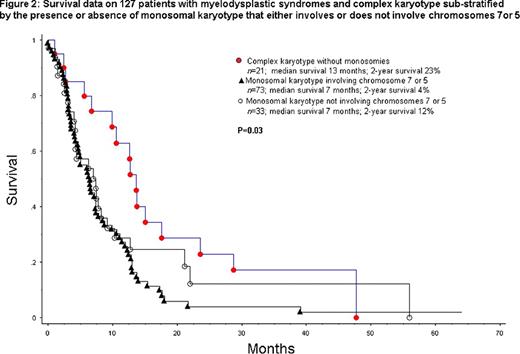Abstract
Abstract 2918
Monosomal karyotype (MK) is defined as the presence of two or more distinct autosomal chromosome monosomies or a single autosomal monosomy associated with at least one structural abnormality (Breems DA et al. J Clin Oncol 2008; 26: 4791). In acute myeloid leukemia (AML), MK has been associated with a worse prognosis than otherwise complex karyotype, regardless of the specific type of autosomal chromosome involved (Breems DA et al. J Clin Oncol 2008; 26: 4791). Whether or not these observations also hold true for myelodysplastic syndromes (MDS) is currently unknown.
To determine if MDS with complex karyotype can be prognostically sub-stratified further based on the presence or absence of MK and if prognosis in MDS with MK is in addition affected by the presence or absence of monosomy 7 or monosomy 5.
The Mayo Clinic database for MDS was used to identify consecutive patients with complex karyotype, defined as the presence of three or more numerical or structural cytogenetic abnormalities. World Health Organization (WHO) criteria were used for MDS diagnosis and leukemic transformation (Vardiman JW et al. Blood 2009; 114: 937). Overall and leukemia-free survivals were calculated from the time of initial cytogenetic studies documenting complex karyotype.
A total of 127 MDS patients (median age 70 years; 79 males) with complex karyotype were identified. Amongst them, 106 (83%) met the above-stipulated criteria for MK and 21 (17%) had complex karyotype without monosomies. The MK in the 106 patients included monosomy 7 and/or monosomy 5 in 73 cases. The three complex karyotype subsets (i.e. complex without monosomies vs. MK that included monosomy 7 and/or 5 vs. MK excluding monosomy 7 or 5) were not significantly different in terms of age and sex distribution, hemoglobin level, leukocyte or platelet count, bone marrow blast percentage or International Prognostic Scoring System (IPSS) risk score. However, survival was significantly inferior in patients with MK compared to those with complex karyotype without monosomies (p=0.01; HR 1.9, 95% CI 1.1–3.3). Multivariable analysis identified MK (p=0.002), advanced age (p=0.0004), increased bone marrow blast percentage (0.04), but not IPSS risk category (p=0.34), as independent risk factors for survival. Interestingly, there was no difference in survival among MK patients further sub-stratified by the presence or absence of monosomy 7 and/or monosomy 5 (Figure 1). Although not statistically significant, leukemia-free survival was also worse in patients with MK compared to those with complex karyotype (p=0.11; HR 2.7, 95% CI 0.8–9.0); none of the aforementioned variables significantly affected leukemia-free survival.
Monosomal karyotype in MDS identifies a prognostically worse subgroup of patients with complex karyotype. Furthermore, in the context of MK, autosomal monosomies other than monosomy 7 or monosomy 5 are prognostically as detrimental.
Survival data on 127 patients with myelodyspiastic syndromes and complex karyotype sub-stratified by the presence or absence of monosomal karyotype that either involves or does not involve chromosomes 7 or 5.
Survival data on 127 patients with myelodyspiastic syndromes and complex karyotype sub-stratified by the presence or absence of monosomal karyotype that either involves or does not involve chromosomes 7 or 5.
No relevant conflicts of interest to declare.
Author notes
Asterisk with author names denotes non-ASH members.


This feature is available to Subscribers Only
Sign In or Create an Account Close Modal